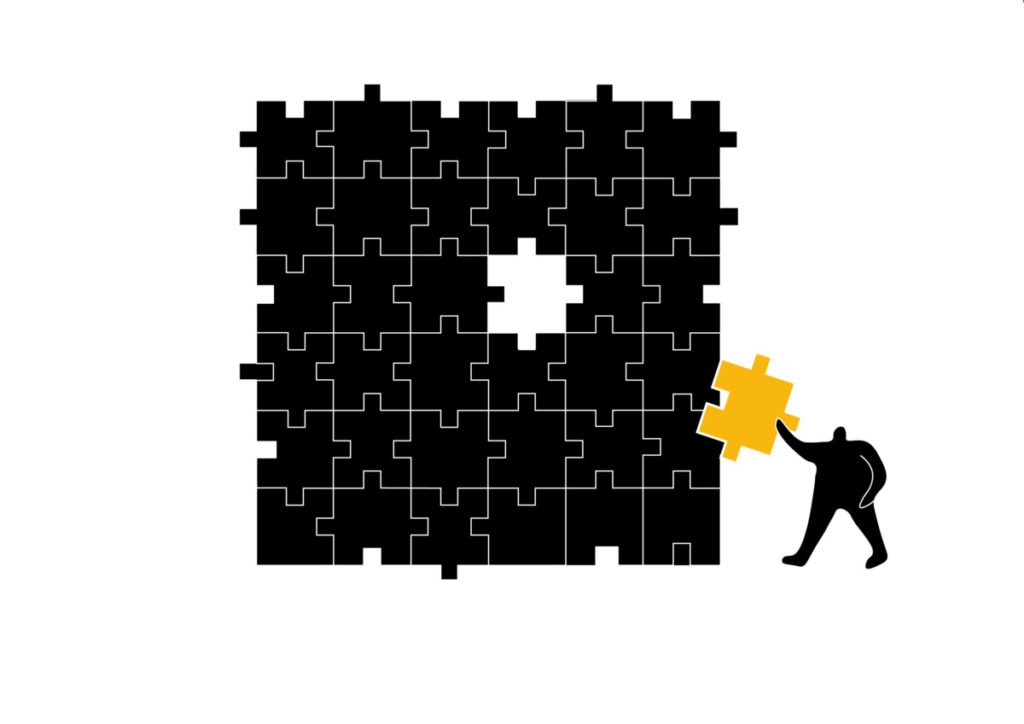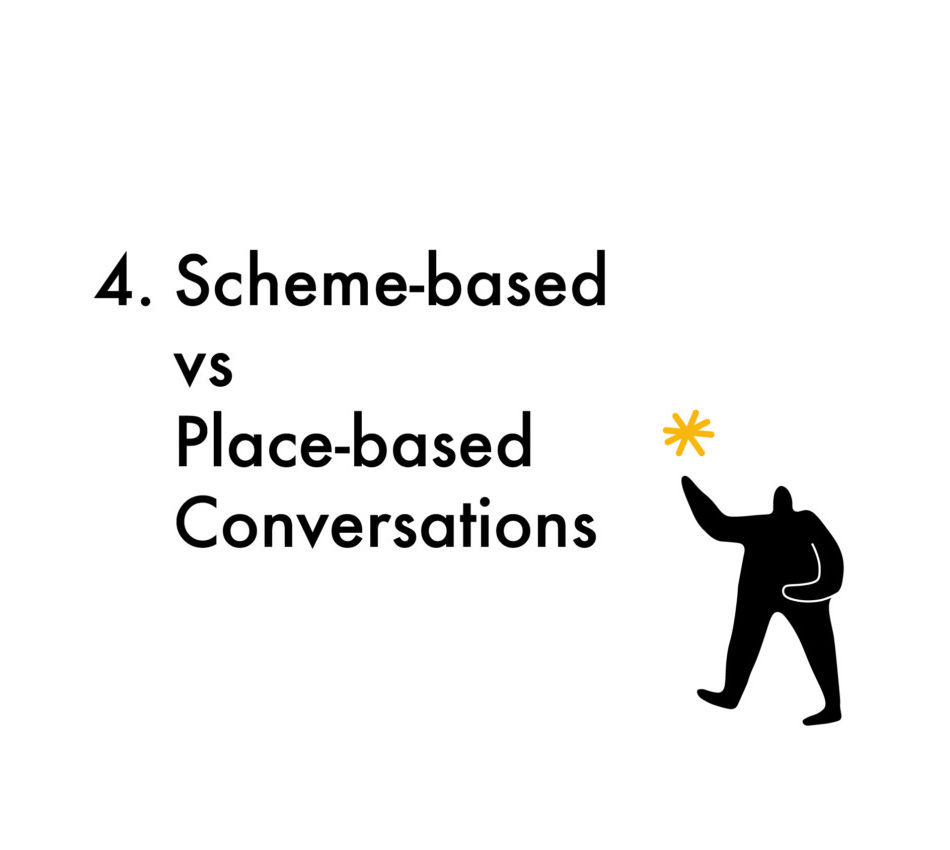Written by:
When asked about some of the potential pitfalls of design engagement, we inevitably end up talking about the difference between a scheme or project-based approach and a place-based approach.

Scheme or Project-based Engagement
Generally speaking, consultation and engagement are instigated in design and placemaking to gather voices, views and contributions regarding a specific planning policy, such as a local plan, or a development or regeneration scheme in the local area, such as a new housing scheme, a mixed-use town-centre development, or regenerating a well-loved area, local building or open space. This project-based approach to design engagement often invites local people and organisations into dialogue to speak about a project operating with limited budgets and timescales for engagement, and under immense pressure to move the project through a series of design and planning stages, in alignment with political calendars and with local and national targets.
This can lead to a few different challenges:
- Engagement being seen as a barrier rather than a resource: The statutory requirement for consultation on schemes, means that it is inevitably seen as a box to tick to achieve planning consent.
- Engagement activities being squeezed to meet project or planning deadlines: While there may be a statutory requirement from consultation, there is very little guidance for or regulation of either the quantity or quality of engagement. This means that it is one of the areas of a project that most frequently gets squeezed or diluted as pressures in other areas of the project mount.
- Consultation fatigue: The biggest problem with each project having its own programme for engagement is that at any given moment, there may be several different project teams trying to engage with the same people and organisations in an area. This is particularly problematic when those being expected to engage are having to take part in their own time, around work and family commitments and without remuneration. One can only ask so much of people.
- Inefficient use of funds: Another problem with project-based consultation and engagement, is that each project is setting up its own engagement infrastructure, requiring departmental resources and producing its own dataset. The truth is that often projects emerging from very different teams ask a lot of the same questions. It would be far more efficient if engagement on one project could better link with and support another.
The Benefits of Place-based Conversations
Our experience of working with locally based communities is that the majority of them would really welcome a conversation about their neighbourhood in broad terms, and that through a more holistic dialogue about their area, they are better able to make informed contributions to conversations about specific sites within it.
Not long ago, I chaired the London Borough of Redbridge Growth Commission, the objective of which was to explore what good growth looks like with local people and organisations, and to formulate a series of recommendations to inform development in the borough. What was so interesting and refreshing about the conversations that we had in this process was that we were intentionally avoiding looking at specific development sites or schemes, and instead looked borough-wide at people’s perceptions of Redbridge. While we were making reference to recent and emerging planning policy, this was not a consultation about one policy in particular. It was simply a conversation about what good growth might look like, and how the pieces of the puzzle might fit together.
A More Holistic Approach to Placemaking
Through a series of open conversations, we were able to explore what was special about the borough, and what people saw as both the opportunities and challenges of regeneration and new development across the many neighbourhoods and ward boundaries within Redbridge. We looked at growth, development and regeneration, but through the lens of place also spoke about: education; health and wellbeing; entry to employment; developing the sector of green construction and retrofit; food growing and guerilla gardening; the different cultural and faith groups in the borough; the role of the arts and culture in today’s society etc. We could link all of these back to design and placemaking, and look at how to make the most of the existing assets as well as how to introduce new ones to respond to what people saw as local, national and global opportunities and challenges.
Looking across Boundaries
One of the first observations that emerged from these conversations was that people don’t think of their local places and neighbourhoods in terms of political or site boundaries. More often than not, perceptions of neighbourhood borders, and of the elements that fit together to make up a neighbourhood, differ from person to person, and vary considerably among those who use, manage, maintain and service a building, space or neighbourhood.
So, whilst red-line boundaries on development sites might have both significance and precision in legal and planning terms, they often do not relate to people’s experiences of place and of their neighbourhood.
When it comes to effective design engagement, while it is helpful to use red-line boundaries to set clear legal parameters of the area of focus, a broader place-based conversation is essential to ensuring that the engagement helps successfully inform design that will help integrate a scheme into its physical surroundings, as well as its socio-economic context. It’s important for us to remember that people and communities do not fit into neat red line boundary boxes, and therefore design engagement conversations and processes must go beyond red lines as a planning tool, in order to recognise places as a more complex web of interactions.
Part of successful design engagement is therefore being able to zoom in and out of site and neighbourhood-focused discussion.
The truth is that there are very few opportunities for communities to come together to talk about how their place is working outside formal planning consultation processes that ask people to respond to change that is already well underway. We have found that creating a conversation which starts from a broader look at how a place is working or could be improved can move the conversation from a position of threat, to one of celebration of what is great about a place and exploration of what is possible.
Connecting People and Initiatives through Place
One of the great advantages of a place-based conversation is that it can bring together initiatives of different scales led by different sectors. Bringing people together to share information about projects in which they are involved can help people understand how their own might complement, replicate or potentially be at odds with what others are already doing locally, or with projects in the pipeline for the future. It can help move initiatives, and people, from a position of competition to collaboration, and usefully create theme or user-based networks such as growing initiatives or support for carers. A place-based conversation can help create more cohesive places, both in terms of a community’s socio-economic networks and in the design of the physical infrastructure that supports them.
We have been experimenting with an approach called Cross-pollination which aims to create a simple mechanism for such conversations, and for mapping local assets and initiatives. We have found that one of the things that people have valued most in this process is that they simply learn more about what is happening in their area. This knowledge is the first step towards useful connections that can lead to collaborations.
It is worth investing in place-based conversations alongside and ideally, as a precursor to scheme-based conversations. As well as creating a more holistic approach, it will help create a community of interest and continuity of dialogue, rather than launching endless scheme-based consultations in isolation, and indeed sometimes in competition for those they hope to engage. This can help move people away from the space of consultation fatigue to a dialogue about how a place is working now, and how it might evolve in the future.
This blog is the fourth in a series of think pieces, which we hope will serve as prompts for discussion, innovation, reflection, and iteration around engaging communities in design decision making, and to encourage others to share ideas, approaches and stories. You can read the rest of the series here.
If this blog, or any other in this series, spark some thinking or experiences you would like to share, we invite you to write your own blogs on these themes or simply to get in touch and explore how we might collaborate on them. You can contact The Glass-House team at info@theglasshouse.org.uk.
Feel free to join the discussion on social media @GlassHouseCLD.


